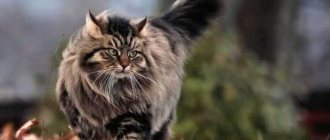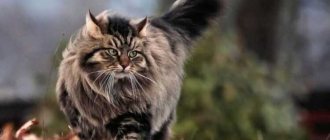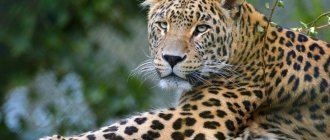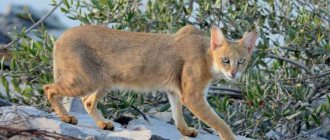Description and origin of the species
The first scientist to catch and describe the jungle cat was the German zoologist Johann Güldenstadt. While on an expedition by order of Catherine II, in 1776 he caught an unusual wild cat on the Terek River, and named it “house”. In 1778, another German zoologist, Johann von Schreber, compiled a scientific description of the new species and gave it the scientific name chaus
). In the 1930s, British zoologist Reginald Innes Pawcock assigned the animal to the genus Felis.
The animal’s closest relatives are other representatives of the Cat genus:
- black-footed cat
- sand cat
- Central European forest cat
- steppe cat
- domestic cat
- Chinese mountain cat
- African wild cat
Is it worth keeping a jungle cat at home?
In short, no, it’s not worth it. There are a lot of other breeds of cats that are adapted to live in apartments, acting as domestic fluffies. The reed cat breed is a purebred predator, capricious and at times dangerous.
There is a chance to tame an animal only in one case - when a small kitten is adopted: from 1 to 2 months old.
Taking an adult is highly discouraged - it is impractical and dangerous for both people and other animals. There is no escape from genetics, and the jungle cat will forever remain a predator.
What does a jungle cat look like? Dimensions and weight
The jungle cat is a graceful, long-legged, medium-sized cat. This is the largest representative of the Cat genus that has survived to this day. House cats are noticeably larger in size than domestic cats and have a more refined build.
The length of the animal’s body including the head ranges from 59 to 76 cm. The height of the predator at the withers is approximately 36 cm, weight varies from 2 to 16 kg. The cat's size decreases from west to east, and similarly from north to south. Thus, the smallest Hausas live in Southeast Asia. The difference in size depending on habitat is explained by higher competition among cats in the southeast. Females are usually smaller in size than males.
The cat has a long and narrow muzzle, with white fur near the mouth. The long ears, 4.5 to 8 cm high, are set close together and have small tufts of dark hair at the tips of the ears. The eyes are yellow, with a narrow long pupil, like those of domestic cats.
The tail, 21 to 36 cm long, is marked with 2-3 black rings towards the end and a black tip. The legs are long: in one step the predator covers an average of 29-32 cm. Due to the long legs, tufts on the ears and the relatively short tail, the house looks like a small lynx.
The color of the cat is uniform, without spots, the color of the fur varies from sandy and light yellow to red-brown and gray shades. Black and white jungle cats, that is, albino and melanistic animals, are found mainly in India. In terms of fur color, jungle cats resemble caracals and African wild cats.
Kittens are often born spotted and striped; the pattern may be partially preserved into adulthood. There are 4-5 dark rings on the back of the front legs; they are hardly noticeable from the front. The fur on the belly is usually noticeably lighter than the color on the back and sides; the fur on the throat is quite light. The fur on the back is noticeably thicker than on the underside of the body. Winter fur is noticeably thicker and denser than summer fur.
Description of the animal
You can recognize such a jungle cat literally at first sight. The animal has a characteristic almond-shaped eye shape and large erect ears. There is a breed standard that allows you to identify such a pet with maximum accuracy:
- The muzzle is elongated.
- The head is massive.
- The eyes are green or yellow.
- The ears are large in adults and have a tuft.
- There are deceptive eyes on the back of the ears.
- Jungle cats have a short, thin tail that makes up about one-third of their total body length.
- The body is powerful, with a wide chest.
- The paws are long.
- The coat is short, smooth and very thick.
- The main colors are silver, black and ticked tabby.
The jungle cat has pronounced sexual dimorphism . Males are always larger than females and at the withers can reach half a meter in height and 120 centimeters in length. An adult jungle cat weighs about 14 kilograms, and cats are no more than ten.
Where does the jungle cat live?
In the wild, the jungle cat lives in the Middle East, Central and Southeast Asia, the Indian subcontinent, Sri Lanka and southern China.
The jungle cat is versatile and is able to live in almost any place where it is not very cold in winter, there is enough water and dense vegetation. The animal lives in swamps, wetlands (wet lands), riverbanks and coastal areas, bushland and grasslands. The predator feels quite comfortable on agricultural lands, such as bean fields and sugar cane thickets, and often settles near people.
House is able to live in areas even with sparse vegetation, although it prefers tall, dense thickets of grass or reeds as a habitat. That is why the animal is called a marsh or reed cat. The predator does not tolerate cold weather well, and rarely lives where snow falls. The animal also avoids tropical forests and sparse forests far from bodies of water, preferring to settle closer to the water.
In India, the House is the most common wild cat. In Iran, it is found on the plains and in the mountains at altitudes of up to 4,000 meters, and lives in 23 of the country’s 31 provinces. In Nepal it rises to an altitude of up to 3,300 meters above sea level; in the Himalayas, a wild cat has been spotted at an altitude of up to 2,300 meters.
In Russia, the Caucasian jungle cat lives along the northwestern coast of the Caspian Sea. In the wild, the animal can be found in the Republic of Dagestan, Ingushetia, Kalmykia, Chechnya, North Ossetia and the Astrakhan region. In the Stavropol Territory, the population is unstable, and rather consists of animals wandering from other regions. The jungle cat has not been seen in the Volga delta since the 1980s, so the population of predators in the Astrakhan region has been practically exterminated.
Life in captivity
Many exotic lovers dream of taming an indomitable predatory animal as a pet. Jungle cats, with their wild beauty, amazing grace and contradictory character, make you want to buy them for any money. Before you decide to buy a house, you need to weigh the pros and cons. There are several aspects to consider:
- The marsh lynx is listed in the Red Book of Russia and is under state protection. You need to purchase an animal only from professional breeders and be sure to check for a veterinary passport.
- Keeping a jungle cat requires a significant investment.
- The animal should be provided with conditions similar to those in nature.
- House recognizes only one owner. Ignores other family members or shows aggression towards them.
- A jungle cat may not live up to the owner’s hopes and will forever remain a wild, uncontrollable animal.
Do not forget that in nature the territory of each individual is several hundred square kilometers. Therefore, it is advisable to keep a cat not in an apartment, but in a country house, where there is plenty of space for a mobile animal. It is better to build a large indoor enclosure, fenced with a strong metal mesh. The dimensions of the fence must be impressive so that the animal feels comfortable staying in it. The floor can be covered with dry reeds or reeds.
The swamp lynx, which lives in a city apartment, needs to be walked periodically so that the animal receives the required dose of ultraviolet rays. It is advisable from time to time to give the jungle cat the opportunity to swim in a natural body of water.
Do not delude yourself that an adult will allow itself to be tamed and become a cute domestic cat. Almost all attempts to subdue an animal accustomed to living in the wild have failed. Only a kitten under 3 months of age can get used to its owner and become a pet.
Jungle cats have very good immunity and excellent health. But to avoid problems, your pet should be vaccinated. For cats kept in apartment conditions, you must purchase:
- a tray corresponding to the size of a large cat;
- special filler;
- large scratching post;
- comb for combing wool;
- toys to entertain an inquisitive animal.
The house gets used to the litter box quickly and does not require constant brushing and bathing. But it needs increased attention, affection and constant joint games. If the owner pays little attention to the obstinate animal, the kitten may get bored and even get sick. The jungle cat is a big owner. He is jealous of the chosen owner of other household members and animals living in the same territory.
Feeding of the swamp lynx living in captivity
First of all, it is worth remembering that the domesticated housefish still remains a predator, so it should eat mainly meat. Certain rules must be followed:
- kittens up to one year old are fed twice a day, adults - once;
- Plant foods should be added to the menu;
- Give the animal special vitamins and minerals.
Daily diet:
- 200 grams of lean meat (chicken loin, beef, veal) and two mice or one rat;
- fish once a week;
- a third of the menu should consist of vegetables.
To prevent a predatory pet from becoming obese, he is given a fasting day once a week. It is not recommended to feed your Hausa cat food or cereal porridge. They contain a lot of fiber, which the Nile cat’s stomach does not digest well. Food from the master's table is also unsuitable food for an animal.
However, even ideal conditions do not guarantee that at a certain time instincts will not take over. The most dangerous period is the mating season. At this time, the animal becomes aggressive and uncontrollable. As soon as the animal reaches puberty, it needs to be castrated or matched. An Abyssinian or other short-haired cat would be suitable. From this union both common and reed kittens are born. Differences appear by three months.
For those who dream of owning a wild cat from the reed thickets, there is an alternative - Hausie cats. They get along well with humans and have a quite friendly character.
Jungle cats are quite friendly towards other animals
Video: jungle cat at home
Character and lifestyle
House is diurnal and hunts during the day. In the midday heat, the cat rests in thickets of bushes, reeds or burrows. In winter he likes to sunbathe. It can also hunt at night, although this depends on the amount of prey available, and they walk 3-6 km in search of prey.
Houses lead a solitary lifestyle, and outside the mating season they do not communicate with their relatives. The only exception is females with growing cubs. Each animal has its own territory, which they mark with scent marks, urine and rubbing their muzzle on various objects. When faced with a rival for prey, a female or territory, the jungle cat emits a loud warning growl and tries to scare the enemy - this behavior is not typical for other cats.
The animal's favorite method of hunting is a sudden ambush attack on the prey, followed by a short sprint or several jumps. The predator usually searches for prey by ear, guards the burrows of water rats and actively searches for bird nests. House is not very fast - the predator can reach speeds of up to 32 km/h, so it rarely pursues prey if it has managed to escape. Like the caracal, the jungle cat is capable of jumping high to catch birds in the air. House climbs trees well and is an excellent swimmer - this wild cat can catch fish by diving headlong after it, and will swim across a river up to 1.5 km wide.
Organizing cat care
Home care includes hygiene control, walks in the fresh air, and grooming. In practical terms, caring for a pet is not difficult, especially if you manage to get along with the cat.
It is not advisable to keep a jungle cat in an apartment due to the lack of free space. The best option is a private house with a wide yard. Walking in the fresh air is strictly necessary for representatives of this breed to maintain normal levels of vitamin D and optimal metabolism of calcium and phosphorus.
Hygienic care includes the following measures:
- The jungle cat is a very clean breed. It is necessary to comb the fur only during the molting period. A special brush is used for this purpose. Maximum attention is paid to the combing procedure so as not to cause pain or discomfort to the pet. To do this, you can alternate between combing and brushing different areas of the body (mainly the space between the ears, head and back). You can try to perform the manipulation while the cat is sleeping. The resulting coarse clumps of hair are carefully cut off without trying to untangle them with your fingers.
- Washing paws after walks helps keep the spaces between the toes and the skin on the paws clean. For this purpose, you should purchase gel or liquid soap with surfactants (designed specifically for cats).
- Bathing should be carried out approximately once a week (this factor depends on the conditions of detention and the individual characteristics of the pet).
To prevent ticks and fleas, tablets, drops, and powder formulations should be used. Regular treatment of your pet for helminths is also important, especially when living in a private home.
A mandatory accessory for a predator is a nail sharpener. It is important to firmly fix the structure.
This can be a production model, or a homemade one: A pipe with ropes, a log.
What does the jungle cat eat?
Like other predators, the Haus eats mainly meat. Prefers mainly small mammals for food:
- rodents, particularly mice and Mongolian gerbils
- hares
- birds, mainly waterfowl (ducks, coots, partridges, pheasants)
- nutria, muskrats, water rats
- fish, mostly carp
- gophers
- wild boars (piglets)
- frogs
- small snakes and lizards
- insects
- small gazelles
Rodents make up at least 95% of the animal's diet. For the most part, the prey consists of small animals weighing up to 1 kg; occasionally the house hunts larger prey, for example, small antelopes. Unlike many other wild cats, Hausas are partially omnivorous and often eat fruit, especially in winter. Near residential villages, cats often carry livestock - chickens, ducks, geese, rabbits. It also does not disdain fresh carrion.
Habitat
Jungle cats love warm climates, which is why their favorite places of residence are Central Asia and the Caspian coast. They also live near the rivers of Africa (Nile), in Thailand, on the island of Sri Lanka, in Palestine, India, Indochina, in eastern Eurasia, and in the Caucasus. On the territory of the Russian Federation, in addition to the Caspian Sea, they can be found in Dagestan and in the lower reaches of the Volga River.
Cats hate open areas, so they go there in rare cases, without going far from their place of permanent deployment. Cats love bushes and reeds, where they feel most at ease and safe. Seals love to settle in coastal shrub and reed areas. Houses are not at all keen on building their homes, but prefer to settle in empty fox and badger holes. They do not live in them for a long time, constantly moving to new places for safety reasons. You can see cat tracks on the shore; jungle cats leave them on the shallows. They swim and dive beautifully, hunting both aquatic birds and fish.
If a cat lives in a mountainous area, then it does not like to climb higher than 800 - 1000 meters, preferring its bushy, often thorny wilds. The cat doesn’t particularly want to have contact with people, leading a secretive and cautious lifestyle. During winter cold and early spring, it can visit human villages, carrying out bandit raids, with the aim of stealing poultry, which it loves to feast on.
We can say that the jungle cat is an omnivore that feeds on almost everything that comes under its clawed paw. He is not averse to feasting on birds, catching them in flight; eggs from nests also form part of his diet. The cat also catches all kinds of rodents (field mice, gophers, martens), sitting by the mink for hours waiting for prey. The cat will not refuse all kinds of insects and even amphibians; it can eat frogs, lizards and snakes. A jungle cat can get itself a white hare, or even a small wild boar, if the opportunity arises. Hunts for birds that live on the water, catches fish. It is no coincidence that he dives and swims beautifully.
It’s worth focusing on how interestingly the cat catches fish. He slowly slaps his paw on the surface of the water, creating the impression of a floundering insect, luring fish
If it swims up, it immediately gets hooked by its sharp claws that are deftly released. To fish it out, the cat plunges its head directly into the water.
Among rural residents, the cat is known as a robber and thief who invades chicken coops, steals chickens and other poultry, and can even steal a small pig. True, the jungle cat does not do all this so often, because... prefers not to come close to human settlements. Basically, robberies occur in the cold winter and early spring, when it is difficult to obtain food.
Reproduction and young
Males and females reach sexual maturity at about 1 year of age. Estrus in females lasts about 5 days. The peak mating season usually occurs in winter, from January to March. During the mating season, loud fights often occur between males over the right to mate with a female. During mating, House cats behave in the same way as domestic cats - the male pursues a female in heat and mates with her, holding her by the scruff of the neck. After successful completion of the process, the female drives the partner away with loud screams, and the couple separates.
Pregnancy lasts almost 2 months. Females prepare a shelter in advance - they line an old hollow, an abandoned den or a secluded place in a reed thicket with grass. Cats typically give birth between December and June, although the timing may vary depending on where the animals live. In one litter, from 1 to 5 kittens are born, with an average of 2-3 cubs. Newborn kittens weigh only 45 to 55 grams, are blind and helpless. The cubs' eyes open from 10 to 13 days, and the mother feeds them milk for up to 3 months.
Kittens begin to hunt independently at the age of 6 months. At 8-9 months they finally leave their mother and go into independent life. In the wild, males do not participate in raising the young, but in captivity they actively protect their offspring.
How to choose a kitten
The future furry family member should be looked after only from the moment the kittens are three months old.
This is due to the vaccination schedule designed specifically for this period.
If you see an affectionate, playful and trusting three-month-old striped baby house, it means that he has tolerated the vaccination well and is ready to delight his new owners.
Moreover, at this age it is already easy to distinguish an ordinary kitten from a real house, because both could appear in the same litter.
Kindness and lack of fear of humans quickly made the Hausi a true favorite among people.
At three months, kittens should be fully socialized:
- go to the litter box when needed;
- get used to the scratching post and cat house;
- communicate calmly and friendly with other kittens and strangers.
The important point is documents; even if you are not going to participate in exhibitions and are buying an animal for your soul, the breeder must provide the necessary package of papers.
Subspecies of the jungle cat
In 2005, the taxonomic reference book Mammal Species of the World recognized 10 subspecies of Hausa. As of 2022, the IUCN Felid Specialist Group recognizes only 3 subspecies.
- F.c.
chaus . Caucasian and Central Asian jungle cat. It lives in the Caucasus, Turkmenistan, Pakistan, Syria, Iraq, Iran, Egypt, Turkey, Tajikistan, and Afghanistan. - F.c.
affinis . Habitat: South Asia. Lives in India, Bangladesh, Sri Lanka, Nepal. - F.c.
fulvidina . Habitat: Southeast Asia: Vietnam, Myanmar, Thailand, Laos, Cambodia.
Pros and cons of this cat breed
A purebred jungle cat is unlikely to be purchased by people who are not familiar with keeping such wild animals. In such a society, the pet will show only its worst qualities:
- aggressiveness;
- independence;
- desire to dominate;
- reluctance to learn;
- hunting habits.
Finding a common language with the Hausi is quite difficult, but still possible.
- A cat knows how to obey its owner and take into account his opinion.
- Becomes a companion on long walks (though only on a leash).
- Representatives of this breed willingly take part in general games.
- Sometimes a cat demonstrates dog-like qualities (for example, bringing something in its teeth).
And in return, the jungle cat will require a lot of attention and respect for its own interests. Here everything is subordinated to the truth, as old as the entire independent cat family - a kind word is pleasant to the cat.
Natural enemies and threats
In the wild, Hausas are hunted mainly by bears, common jackals, leopards, crocodiles and large snakes. In addition, the cat has to compete for prey with other predators - foxes, the same jackals, forest cats and birds of prey, for example, marsh harrier.
The main threat to the Hausa is humans.
- The animal's habitat is rapidly declining due to the draining of swamps, the construction of dams, the development of agricultural land and urbanization.
- In Turkey and Iran, the animal is actively hunted by poachers. Illegal trade in skins continues in India, Egypt and Afghanistan.
- In Southeast Asia, the number of individuals has decreased significantly in recent years due to active hunting of the animal by hunters for the sake of its skin and for souvenirs. Hausas are hunted most often in Laos, Cambodia and Vietnam.
- In Jordan, Syria and Palestine, the Hausa population suffered serious losses due to the expansion of agricultural areas along the Jordan River and its tributary Yarmouk. Farmers in these regions shoot and poison cats en masse for attacks on poultry.
Lifestyle
The jungle cat's favorite places to rest are areas near water bodies. The animal settles on the ground or in an old badger hole. It uses reeds or reeds as flooring. The cat does not dig its own holes.
The predator prefers not to appear in open areas. He moves through the thickets. He does this very quietly and unnoticeably, although he has quite an impressive weight.
He usually leads a solitary life. The exception is the breeding season. Then the predator finds a mate, and together they take care of the offspring.
Representatives of the breed are excellent swimmers and divers. This is how they get their food. But even if there is no need for fishing, these animals still require daily exercise in the pond.
The reed predator has excellent hearing, largely due to its erect ears. But his vision and sense of smell are developed at an average level.
Population and conservation of the species
There are only about 500 wild hausas left in Russia.
The jungle cat is listed as a species of Least Concern by the IUCN Red List and on Appendix II of CITES (restricting international trade in animals). In Russia, the reed cat is also listed in the Red Book of the Russian Federation as a rare, endangered species.
Hunting the animal is prohibited in Bangladesh, China, India, Israel, Pakistan, Myanmar, Tajikistan, Thailand and Turkey. Outside the reserves, the animal is not protected from hunters in any way in Bhutan, Georgia, Laos, Libya, Nepal, Cambodia, Sri Lanka and Vietnam. In Russia, hunting Hausa is allowed only in exceptional cases, with a special permit (license).
Feeding
In nature, Hausas do not eat porridge. Therefore, you should not offer them a cereal menu at home. But live food, no matter how humane it may be, will have to be fed to the jungle cat every day. After all, what does a jungle cat ideally eat? That's right, game.
The traditional daily diet of an ex-savage looks like this: 200 grams of lean meat plus a couple of live mice (or one rat). As an alternative, high quality Orijen cat food (link to the official website).
Jungle cat at home
A purebred wild reed cat is difficult to tame. Having one at home would not be the best idea. Firstly, it will be difficult to buy a purebred wild house kitten, and besides, you may be very unlucky with its character. Purebred houses can be wild, they often run wild with their owners, destroy apartments and refuse to eat from their hands and do not cuddle like ordinary domestic cats.
For those who still want to have a domestic jungle cat, there is an excellent solution - the Chausie. The Chausie, or Hausie, is a new breed of cat, a cross between the jungle cat and the Abyssinian cat. The kittens inherit the unusual appearance and unique exterior of a swamp lynx from their purebred Hauss father, and their affectionate and flexible character from their Abyssinian mother.
Chausies are similar in character to ordinary domestic cats; they are affectionate, energetic animals that love to walk, swim and become strongly attached to their owners. At the same time, they inherit the unusual appearance of the swamp lynx - a muscular body, long limbs, ears with black tassels, gray color. Chausies are larger in size than Maine Coons and live up to 20 years. It is quite possible to buy a kitten of the 1st-3rd generation (F1-F3) for 100 - 300 thousand rubles, the price depends on the generation, pedigree and breeder.
History of the breed
The Egyptians are considered to be the very first whom the jungle cat chose as its owners.
At least, records dating back three thousand years indicate exactly this.
In the homes of Ancient Egypt, two types of cats were kept, one of which was Felis chaus, and the other was the incredibly beautiful Egyptian Mau .
This breed was preferred due to its attractive character traits.
The jungle cat has excellent hearing thanks to its large ears.
It is from Latin that the modern interpretation of the name of the breed comes - “house” or “chaus”.
In addition to Ancient Egypt, the jungle cat or house lived in about 25 countries around the world.
But mostly there he was considered wild, and no one thought of inviting him into their home.
Although these cats showed genuine interest in human habitation, they often came very close to it.
House is perfectly adapted to living in dense reed thickets
And only at the end of the 18th century, in 1777, cat lovers bred a hybrid that resembled the modern variety of the House breed.
Then, already in the 20th century, Americans, as a result of crossing domestic shorthair cats with wild reed cats, received a modern version of these cats, combining an extraordinary appearance and a friendly disposition.
In an apartment it’s good, but in a private house it’s better...
To keep a large, active animal you need a spacious apartment with sturdy furniture. After all, large and sharp claws can easily turn your home interior into tatters. It is better to have such pets in a country house with a separate enclosure for the pet. So that the furry baby has a place to sharpen his claws and frolic to his heart's content. Yes, I would like to remind you that the swamp lynx loves water, so a pool with fish can also come in handy.
Caring for offspring
Kittens appear two months after mating. One baby can weigh up to one hundred grams. Like ordinary felines, kittens are born blind. Their eyes open on the seventh to tenth day.
The mother feeds the cubs with her milk for three months. From the age of two months she feeds them regular food. All this time, the male is nearby, helping with food acquisition and education. Kittens are considered independent from the age of five months, and at the age of eight months they already become sexually mature individuals. Then each of them goes to their own territory to lead a separate lifestyle.
Chausi
When it became clear what a jungle cat looks like, it’s worth learning more about its hybrid version, which is commonly called chausi. Breeders created a friendlier breed by crossing a wild animal with a domestic short-haired pet.
A person can have one at home without fear of the appearance of predatory instincts. However, this does not mean that the pet does not need to be given a lot of attention. These animals love to play and swim. If the family has other pets, it is necessary to pay more attention to the reed predator. Otherwise, he may harm his neighbors.
At home, the reed species needs to be fed once a day. Beef or other lean meat is perfect as a main food. It should be fresh and raw. You can diversify your diet with the help of rats and mice. Young chicks or quail are also suitable. Fish should be given once a week. To prevent your pet from gaining extra pounds, he should have a fasting day once a week. Living at home, he does not expend enough energy, so you need to protect him from obesity. Since the pet will not be able to get its own food, it needs to add fresh herbs and vitamins to the menu. You can't offer porridge!
Domesticated individuals are docile and graceful. To prevent the cat from accumulating a lot of excess energy, which can escape at the most inopportune moment, it is worth exhausting it with various games.











